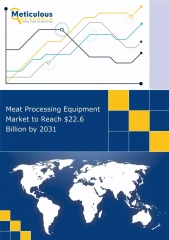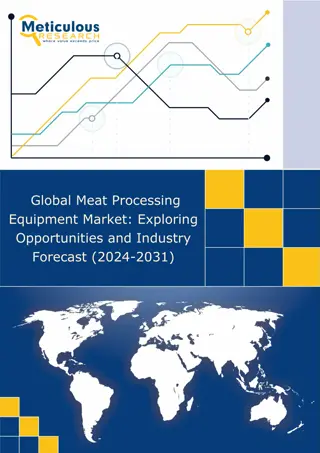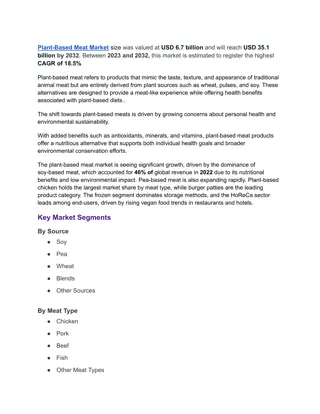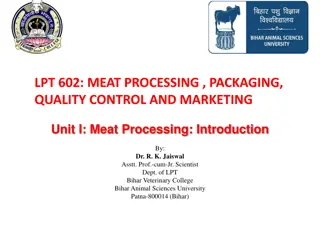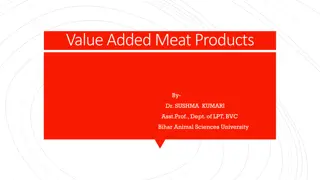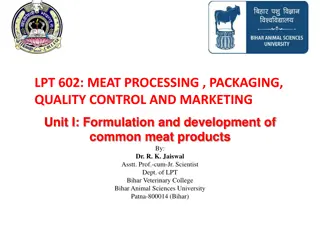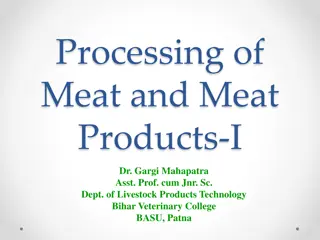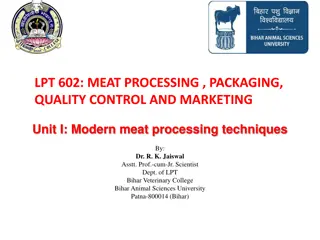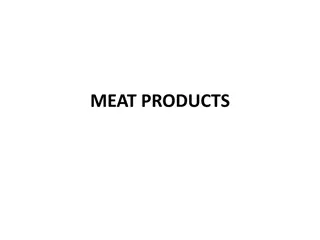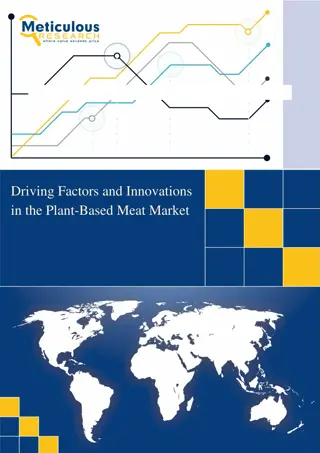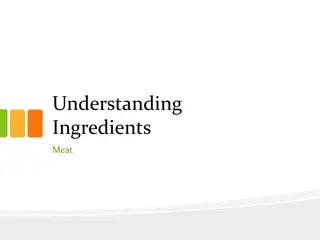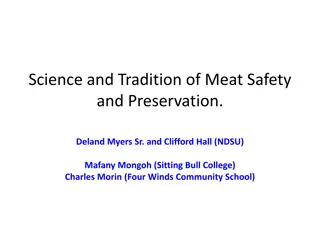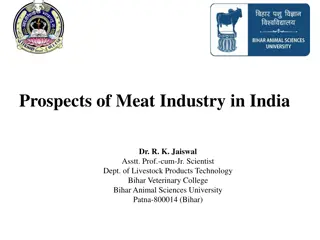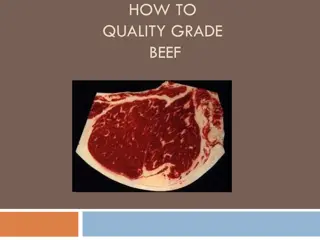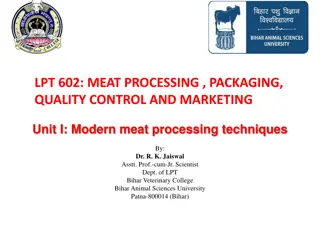Understanding Meat Microbiology: Challenges and Growth Phases
Meat microbiology is a crucial aspect of food science, focusing on organisms present in red meat, poultry, fish, and their products. This field addresses both preventing food spoilage and protecting consumers against foodborne illnesses. Challenges arise from slaughtering to home consumption, where microorganisms can lead to spoilage due to enzymatic activity. The growth curve of bacteria involves phases like lag, logarithmic growth, maximum stationary, and decline phases, influenced by factors like water and energy sources. Understanding microbial growth requirements is essential in ensuring food safety and quality.
Download Presentation

Please find below an Image/Link to download the presentation.
The content on the website is provided AS IS for your information and personal use only. It may not be sold, licensed, or shared on other websites without obtaining consent from the author. Download presentation by click this link. If you encounter any issues during the download, it is possible that the publisher has removed the file from their server.
E N D
Presentation Transcript
MEAT MICROBIOLOGY PROF. DR. FAHIM SHALTOUT PROFESSOR OF MEAT HYGIENE FACULTY OF VETERINARY MEDICINE PROFESSOR BENHA UNIVERSITY, EGYPT EMAIL: FAHIMSHALTOUT@HOTMAIL.COM
INTRODUCTION The meat microbiology as a part of the food microbiology science , deal with organisms that are present, contaminate , or grow in and on red meat, poultry , fish and their product and divided into:- 2- Prevention of food spoilage 1- Protection of consumer against food borne diseases
Meat microbiology, challenges begin with the slaughtering operation of food animals or birds until consumption of their meats at home. Microorganisms play different important roles during this long chain of meat preparation. Meat like all food stuffs is acceptable and susceptible to be invaded by microorganisms and this lead to production of unattractive changes (Spoilage) and this due to their enzymatic protealytic activity.
THE GROWTH CURVE OF BACTERIA Stationary phase 3 4 Decline phase Log of cell number Log phase Lag phase 5 1 2 Time
In a favorable environment growth curve of bacteria showing the four phases of growth. 1- Lag phase:1-2 - After a short period of adjustment to the new environment. - During this period the cells increase in size and produce new materials but active division does not take place. 2- Logarithmic growth phase:2-3 - Growth begins accelerates to a phase of rapid, constant, exponential growth. - phase each cell in the population is duplicated and the formed cells are viable and of constant size.
3- Maximum stationary phase:3-4 In the time the environment will change due to the growth of the bacteria causing a depletion in nutrients and an accumulation of waste products (toxic metabolic products) results in a decrease in the growth rate. 4- Decline or death phase:4-5 - The final phase in the growth curve. - Represents a period when the death rate exceed the rate of multiplication.
REQUIREMENTS OF MICROBIAL GROWTH
1- water Growth and welfare of M. Os Molds have the lowest requirement, followed by yeast, gram negative and gram positive. 2- Source of energy Carbohydrates and amino acid are commonly used as carbon and energy sources. - Fats are used also by M. Os, as a source of energy ( Fat hydrolyzed with the aid of Lipase enzyme glycerol + fatty acid. - Sugar, alcohols, amino acid , starches, cellulose, fat source of energy. -In general molds can grow in the highest concentrations of sugars and yeasts in fairly high conc., but most bacteria grow best in fairly low conc.
3- Source of nitrogen - The primary nitrogen sources utilized by heterotrophic M. Os are amino acid - The organisms different in their ability to use individual amino acid for energy and in their action on them. 4- Vitamins - Vitamins such as thiamin, riboflavin and nicotinic acid which are required for enzyme synthesis. 5- Minerals
NATURAL SOURCES OF CONTAMINATION from edible plants as flavobacterium, Achrombactor from animals as E. coli + streptococci from sewage true faecal type (Coliform enterococci From water as pseudomonas. from air as Mold , yeast + Aerobic spore former.
SOURCES OF MEAT CONTAMINATION B- Exogenous way A- Endogenous ways
A- ENDOGENOUS WAYS A1 - Diseased Animal (when the animal is affected by some infections disease as T.B, Anthrax . etc. A2- Lowerd natural resistence due to stress M. Os invade the intestinal mucosa and distribution by blood and lymph to different organs and tissues as E. Coli and as well as anaerobic M. Os Bone taint deep muscular putrefaction. The flesh of animals slaughtered either ill or exhausted either ill or exhausted possesses a high PH value alkalin and may have a high blood content, both of these condition favorable to bacterial growth.
It must again be stressed therefore that slaughter should be prohibited until the animal have been rested and have entirely recovered from the effect of transportation. It is show that inadequate rest period may reduce the quality and shell life meat due to the following 1- Incomplete developing of acidity of muscle high PH. 2 - Early invasion of the system by spoilage M.Os from the intestinal tract Bone taint and ham taint in pig. 3-Decrease oxygenation of hemoglobin and muscle myoglobin dark colour.
B- EXOGENOUS WAY Every treatment deals with the food animal from the point of slaughtering until it is ready for consumption including preparation of the carcase, transportation and handling will add to the bact. Load of meat.
B1- Surface of the carcase B-1-1- From exterior ( soil and hide) Harbor large number of different kinds of M. Os as yeast , mold , proteus, micrococci on which the animal carry especially in winter time (the animal entering the slaughter house are often very dirty and legs covered with manure). The skin is the main sources of the contamination of meat. It is necessary before slaughtering that the animal should be thoroughly washed. Skinning machine is better than manual one and more preferable. Skinning by hand more contamination than in case of machine skinning as the hands transfer the bact. From the skin to the surface of meat during hand skinning.
B-1-2- During carcase preparation & Evisceration Many M. Os (as E. coli, Enterococci, Clostridia ., etc) are present in the small intestine to carcase and the bact. Number in colon & rectum (106-109/gm) B-2- Equipment and tools Tools, knives and other equipment used during skinning, preparation and processing of meat act as source of contamination so , to retard this they must be dipped for 5 sec in a bucket with boiling water. And it is necessary that water is thoroughly changed and boiled.
B-3- The hands and cloths Worker hands often contain a considerable number of M. Os in the skin folds and under the nails food poisoning as sal, staph, Shigella sonni, Shigella desentery SO, hands can be easily cleaned by keeping the hand in water at 60 c for few seconds. This will remove all the loose meat particles and fat and the more fixed dirt is moistened so that the following washing is easier performed. It is necessary that one needs warm water and a good alkaline detergent to clean effectively. B-4- Flies, rodents and stray dogs
B-5- Air More dust lead to contamination pollution of the abattoir at mosphere and So, contaminate the carcass surface. B-6- Transport and storage The packaging meat into crates, boxes and other containers were contaminated or soiled from air, cloths and during transportation. It retail market, shops, saws, slicer, mincing machine and refrigeration (Cold storage). B-7- The faults which may occur during evisceration. The gut of the animal contains great amount of M. Os but great difference in number and kinds will be found in different part of digestive tract the outer surface is more exposed to contamination from the hide while the inner surface (the thoracic and abdominal cavities) and the organ are equally apt to the gut or from the voided manure through faulty evisceration.
FACTORS AFFECTING THE MICROBIAL GROWTH ON MEAT
1- Ienitial count The rate of bact. contamination in meat depends upon the conditions under which it is produced, a good sanitary condition prolong storage time or shell- life. 2- Avilable oxygen Bacteria have a range of activities with regard to their oxygen requirements. Classification of M. Os according to their ability to use free oxygen, microcrganisms have been classified as. 1- Strict or obligate aerobes: - when they require free oxygen. - strict aerobes in the food environment (e.g. Micrococci Bacuillus subtilis, B. megaterium, Bseudomonas, Acinetobacter and Moraxellae) use oxygen as the terminal electron accept or in respiration. - Slime may be at the surface of meat by growth of pseudomonas 2- Strict or obligate anaerobic: - When they grow best in the absence of free oxygen. - Certain members of the genus Clostridium.
3- Facultative - when they grow well either aerobically or anaerobically. 4- Facultative anaerobes - Can use as a terminal electron acceptor but its absence they can use a variety of electron acceptors (NO3, SO4) E.g. Lactobacillaceae, Enterobacteriaceae. - They grow on the surface and in the interior of foods; some prossess proteolytic or lipolytic activity. - They are important food spoilage organisms. - Some such as Enterobacteria are organisms of public health significance. 5- Microaerophiles - Have a requirement for oxygen but at concentration considerabily below those present in air. These bacteria including many Lactobacilli, Streptococci. - There is a relationship between the oxygen tension that is the concentration of oxygen in the environment and oxidation- reduction (OR) potential. N.B. Molds are aerobic, most yeast grow best aerobically. - Anaerobic bone taint -Mould & yeast growth on surface. - Ozone & CO2 are effective in retarting surface spoilage of beef quarters under long storage.
3- Relative humidity ( RH) All microbes absorb nutrient substance in water solution from meat when they develop on solid media. Drying or in salt conc will the number of developing bact., because the amount of water assimilated by bact. Relative humidity (RH) of the environment within foods and the growth of Mios on surfaces. - When food with low aw values placed in an environment of high RH the foods pick up moisture till equilibrium has been established -likewise foods with a high aw lose moisture when placed in an environment with low R.H. Food aw + R.H. equilibrium Food aw + R.H Loss moisture
* Food that undergo surface spoilage from molds yeasts and certain bacteria should be stored under conditions of low R.H. * The high temperature & lower the R.H. and vice versa must be borne in mind when selecting storage environment for storage of food. N:B Improperly wrapped meats such as whole chickens and beef cuts tend to surface spoilage occurs due to the generally high R.H. of the refrigerator and the fact that the meat spoilage flora is essentially aerobic in nature , while it is possible to lessen the chances of surface spoilage in certain foods by storing under low conditions of R.H. - By altering the gaseous atmosphere it is possible to retard surface spoilage without lowering R.H.
4- temperature:- Temperature is an important factor affecting growth and metabolic activity of M. Os each group of M. Os has their specific temperature. * Environmental. Temperature reflects on the growth and kind of M. Os Temperature is probably the most important environmental factor affecting the growth and viability of M. Os. Microorganisms grow over a very wide range of temperatures. - The temperature of a growth medium or food determines the rate of growth of any bacteria associated there with - Optimum temp: The temperature at which growth is most rapid (grow and multiply well) e.g. enzymatic reaction of M. Os progress at maximum speed. - Maximum temp. is the highest temp . at which the organism will grow , this is usually only a few degree above the optimum temp. and can not multiply above it destroyed.
-Minimum temp. is the lowest temp. at which growth of the organism occurs and is usually substantially below the optimum temp. - Thermal Death point TDP Is the temperature at which an organism is killed in ten minutes (time constant & temp= variable). - Thermal Death Time TDT Is the time required to kill a suspension of cells or spore at give temp (temp constant & time variable). The major physiological groups of bacteria based upon their temp requirement for growth. 1- Psychrotrophes 2- Mesophiles 1- Psychrotrophs These organisms grow well at refrigerator temp (7 C) and spoilage of meat, fish, poultry, held at this temperature. 2- Mesophilic: These organism grow well at room temp. (37 C). Many of animal or human origin including all pathogens and many food spoilage types. Genera: Strept, faecalis 3- Thermophilis
3- Thermophilic At this organism grow well at 55C they mainly found in canned food Minimum temp Optimum temp. Maximum temp. Psychrotrophs 0 C 7 C 10 C Mesophilic 25 C 37 42 C Thermophilic 45 C 55 C 80 C
Relationship between temp. & growth rate of M.Os e.g. in meat. Rate of penetration of M. Os inside meat depend on the temp. Temp penetration of M, Os inside meat. * 2kg of meat at room temp. the microorganism can penetrate 3 cm in 24 hrs 14 cm for pathogen *2 kg of meatat37 C the M.Os can penetrate *2 kg of meat at ( 2-4 C) the M. Os not morethan 1 cm in 30 days.
5- MEAT REACTION ( P.H): - PH of meat is amphoteric in action - Although different M.Os can grow best at PH value around 6.6-7.5, most bact. Grow better at PH near the neutral, while molds and yeast quite talarant to acid. - yeast can grow at PH 1.5-8.5 (4-4.5) - Mold can grow over wide range of PH2-11 but favour an acid medium Putrefactive M. Os needed high PH.
norm al PH7 DEF PSE Ihr PH 5.5 24 hrs
The PH of freshly slaughtered healthy animals usually neutral (slight acidic or slight alkaline) that range from 6-8 7.2 toward netural. R.M. ( Rigor- Mortis) begins 2 hrs after slaughter and PH of meat gradually changes to acid side due to lactic acid formation (usually 1% glycogen is converted into lactic cid depression in PH values). - After 20-24-48 hrs PH of well rested animals is 5.3, 5.8,6. - The PH then remain constant for sometimes and this period depend on: - Condition of animals before slaughtering - Storage conditions - The degree of the initial bacterial contamination
- Later on PH begins to rise slowly due to autolysins and bacterial growth. - When PH is reached 6.4 suspicion of the presence of decomposition. - When PH is reached 6.8 objective signs of decomposition become apparent in the meat in the form of a change in odour (off odour) and in colour (greenish colour) and the texture (loose and flabby). - The duration of such change in PH differ from animal to animal - Meat from fatigued animals spoils faster than that from rested animal -In healthy animal, the PH drops gradually and remain constant for a time then rise gradually. - In diseased or fatigued animal the PH drop suddenly and rise suddenly in pigs PSE (Pale Soft Exudative) rapid drop PH 6.1 5.5 within 45-60 min while the carcass still warm.
In beef DFE PH is more than 6 after lapse of 24 hours Dark = D = dark red in colour Firm = F= firm in consistency Dry= D= a feeling of dryness of m. fiber.
6- Oxidation Reduction Potential (Eh): OR is essentially a measure of the oxidizing or reducing capacity of the medium. Def: As the ease with which the substrate loses or gain electrons. When an element or compound loses electrons the substrate is said to be oxidized, while a substrate that ins electrons reduced. *Therefore a substance that readily gains up electrons is a good reducing agent. *While one that readily take up electrons is a good oxidizing agent. A highly oxidized substrate would have + ve Eh Aerobie M.Os. A highly reduced substrate would have ve Eh Anaerobic M.Os. If a strong reducing agent is presem it will lower the OR potential growth of an erobes, conversely since oxygen is an oxidizing agent its presence ensure relatively high OR potential and encourages the growths of the more aerobic M.Os
The OR potential may also be increased by increasing the cone. of other oxidizing agents allowing aerobic bacteria to develop in conditions devoid of oxygen itself. In meat Eh range from 150 to + 250 mv. There is oxygen requirement for PM tissue. The Myoglobin of muscle can bind oxygen to from oxymyoglobin or it can be oxidized by oxygen metmyoglobin. * The surface of a piece of fresh meat would have have aerobic conditions support aerobic growth of slime forming or souring at the same time as anaerobic putrefaction was proceeding in the interior (Clostridium spp.) * In pre-rigor meat the is sufficiently high to prevent the growth of anaerobic types, but during rigor Eh is reduced to allow Cl. spp. The fall in Eh during storage of a food has been attributed to the liberation of gaseous H2 and of reducing metabolites by food enzyme or actively growing M.Os
* processing may remove oxidizing or reducing substance. - Initial redox value between 20 to 150mv is optimum for canned meats. During long periods of storage the redox of canned pork and beef may drop to 350mv unfit for human consumption. Ex: oxidizing nitrite Reducing ascorbic acid
7- MOISTURE CONTENT: - Water account for some 80-90% of total weight of the living cells, the growth and metabolism of m.os demand the presence of water in an available form However, in the processing of food such as drying or freezing, the water is removed or remain in solid state which make it unavailable for the organisms to carry on their normal metabolic activity. - The exact amount of water needed for growth of m.os varies. Bacteria require more water than yeasts which require water more than molds. - The most useful measurement of the availability of water is water activity (aw) water requirement for growth of m.os.
Water Vapor Pressure of Meat P Water Vapor Pressure of pure aw = Water P0 N.B: Pure water has aw = 1 Relative humidity (RH) = 100 X aw - Each m.os has a maximal, optimal and minimal aw for growth. - Bacteria require more moisture than yeasts and yeasts which require water more than Molds There for: * Bacteria and yeasts are Hydrophilic m.os = water loving. * Molds are xerophilic = Dry loving as they need or can grow in low moisture content.
* Halophilic bacteria: (salt loving), bacteria can grow at aw 0.77 (require minimal cone of dissolved of Nacl for growth and their types are: 1- Slight halophiles tolerate salt up 5% 2- Moderate halophies tolerate salt up 20% 3- Extreme halophiles tolerate salt up 30% 4- Haloduric bacteria they are merellay tolerant to salt. Salt tolerant they can grow with or without salt. Halophilic and haloterant bacteria may be important in highly salted foods and in salt brines. Genera: Halobactevium Sarcina Vibrio Micrococcus Pseudomonas Pediococcus Alcahgenes.
* Xerophilic = Dry loving those growing rapidly under relatively dry conditions or capable of growth at aw below 0.85 (yeast, molds) can grow at aw 065. * Osmophilic = sugar loving yeast grow best in high cone. of sugar and it can grow at aw 0.60, but most bacteria called osmophiles are merely sugar tolerant e.g., spp of leuconostoc. N.B: Most spoilage bacteria do not grow below aw 0.91 Most spoilage yeast do not grow below aw 0.88 Most spoilage mold do not grow below aw 0.80 (S. aureus can grow as low as 0.86 aw) While: - Halophilic bacteria can grow at aw 0.77 - Xerophilic fungi can grow at aw 0.65 - Osmophilic yeasts can grow at aw 0.60 * Gram ve bacteria having higher requirement water than Gram +ve Growth of aerobes takes place at a lower aw in the presence of air than in its absence, and the reverse is true of anaerobes. Most organisms are most tolerant of low aw at pHvalues near neutrality than in acid or alkaline media. Most organisms have the greatest tolerance to low aw at about optimal temperature.
WATER IS MADE UNAVAILABLE IN VARIOUS WAYS: * Solutes and ions tie up water in solution such as sugars and salts is in effect a drying of the material. * Hydrophilic colloids (gels) make water unavailable 3 to 4% agar in media prevent bacterial growth by leaving to little available moisture. * Water of crystallized or hydration is usually unavailable to m.os, * The aw range of 0.995 0.980 is best for most bact. and spoilage is encouraged in meat. * At aw 0.98 0.93 spoilage by Gram ve bact. gives ways to spoilage by certain Gram + ve bact. * Below 0.93 0.85 micrococci, yeast, molds. * Below 0.85 0.60 certain fungi and yeast predominate. * Below 0.60 there is no growth.
8- GROWTH OF CONTAMINATION: Mainly depended upon the following. 8-1 Associated microbial growth As bacteria grow faster than yeast and mould and each produce it is characteristic spoilage type. The kind and the amount of contamination with m.os and the spread of these organism in the meat. N.B: Microorganisms can be broadly classified according to their effect on the food, into three major groups: 1-Those beneficial to Haman as bacteria induce fermentation as lacto bacilli used in fermented sausage. 2- Spoilage bact. That cause spoilage or decomposition. 3- Harmful or pathogenic ones that cause health hazards on human as disease or poisoning.
8-2 Environmental conditions: * Exposed surface minced meat enhance the distribution of m.os and their growth and multiplication. The amount of exposed surface of the flesh air available for aerobic organisms. * Meat considered as enriched media for containing protein, glycogen, fat, minerals enhance microbial growth Fat may protect some surface but is subject to spoilage it self. * Moisture Content (aw) is one of the important factor as available water for enhancing microbial growth.
FACTORS THAT INFLUENCE INVASION OF TISSUES BY MICROORGANISMS. 1) The load in the gut of the animal the greater the load the greater the invasion of tissues, for that reason starvation for 24 hrs before slaughter has heen re commended. 2) The physiological condition of the animal immediately before slaughter. If the animals is excited, feverish or fatigued, bacteria are more likely to enter the tissues, bleed is apt to be incomplete, thus encourage the spread of bacteria and chemical change may take place. More readily in the tissue better bacterial growth up in fatigue .Earlier release of Juices from meat fibers and more. higher PH because glycogen is used 3) Method of killing and bleeding: * The better and more sanitary bleeding better K.Q of meat. * Electrically stunned animal is than from those killed with Co2 4) The rate of cooling. Rapid cooling will reduce the rate of invasion of the tissues by m.os.
How to produce meat of good keeping quality, prophylactic measures to produce high quality meat or Method for reduction contamination. The following items should le noticed to produce meat of high keeping quality. 1) prevent m.os from contaminations carcasses F. 2) remove contamination and its sources F. 3) prevent or retard bacterial growth.
1] PRE SLAUGHTER PRECAUTION: 1. Selection of the healthy animal in farm free from (food additive, Antibiotic or food affect on odour of meat) *** transportation of animal to slaughter house and crowded is prevent . adequate lariage for each animal *** Slaughtered animals were kept in laiarage for at least 24hrs to rest, and tried animal for 72 hrs and not more to prevent cross contamination, with normal feeding and watering. *** keeping out without feeding for 12 hrs (during night). *** Allowing drinking water for 3-4 hrs (to wash the gastro intestinal tract and to give chance to meat to free themselves from various toxin).
Before slaughtering. 2. Carefully A.M.I befor slaughter. Any deviation of normal temp. should be recorded and corrected with suitable treatment without effect on meat itself. Before going slaughter house. * forbidden to be slaughtering animals affected with fever. ** Diseased or suspect to be diseased animal with (Anthrax, rabies, Enterotoxaemia botulism) forbidden to be slaughter & Abattoir hall disinfected. *** Animal affected with infectious diseases as (T.B, Brucellosis, Listeriosis) Slaughtered in detention room and disinfected
Prophylatic disinfection: * remove the deposite and fat by warm water and put disinfect ant as: - Caustic sodia 2% at 70-80c - 20% suspension of formaldhyde - chloride of lime with 2% active chlorine Emergency disinfedant: - 10% caustic soda solution - active chlorine 5% of chloride of lime. - 40% formaldehyde. In case T.B use 3% formaldehyde. Caustic soda.
Characterized of disinfectant: High effective Not inflammable not metal Not metal corrosion 3) cleaning of animal with spray water before slaughtering to remove dirts especially at winter. ** water used for skinning and evisceration should be bact. exam. every week.
2] DURING SLAUGHTER: - Sterile knife used in slaughter cattle, pig. - Hiding process must done mechanically by machines, attention taken to prevent surface contamination. - Evisceration should be done directly after slaughtering to avoid substitution of organs and contamination. - Stomach & intestine special department to remove their content. - Cleaning of carcasses by running water. - Inflation of carcasses forbidden. 3] During examination of meat: - Avoid contamination of healthy part by diseased one. - Meat inspector have 2 knife, one for diseased and one for healthy parts. - Avoid more inscion in carcasses.
4] AFTER SLAUGHTER PROCESS: Meat should le immedially chilled after to prevent bone taint. Good aeration of the carcass if no chilling room. - Air contamination Avoided by: * plantation of tree around abattoir. * Air filter or ventilators with screamed windows. - Air is bacteriologically exam. Every week. - Instrument, clothes, equipments, utensils and slaughter hall cleaned & disinfected. - Avoid the presence of rodents and flies. - strict hygienic measures for transportation and handling of meat from time of slaughter till be ready to eat. - Butcher's shops should be put under strict hygienic inspection and must be well constructed. - Regular and periodical exam. For butcher and employees to emphasize free from infectious disease.


